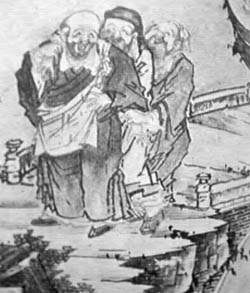 | |||||||||||||||||||||||
|
|
D. T. Suzuki once said, "Zen is the only religion or teaching that finds room for laughter." R.H. Blyth also said, "the essence of Zen is humour." From a Western standpoint, and even from a traditional Buddhist standpoint, attributing the comic with the sacred seems sacrilegious. G. F. Meier, a German philosopher, warned that we should not jest about things that are serious. Thus, associating a religion like Zen with laughter is a definite problem for some. In no other major religion do we see such a reliance on humor. As Christmas Humphreys remarked, "There is more honest 'belly-laugher' in a Zen monastery than surely in any other religious institution on earth." Associating laughter with religion was even a problem for early Buddhist scholastics. Laughter was thought to be something common, even vulgar. Some see the comic as a distraction from the seriousness of religion, while others view it as adding "spice to the rice," so to speak. Thus, Buddhist scholastics preferred to disassociate the Buddha's teachings from laughter. However, there was a problem: many sutras say or imply that the Buddha would laugh on occassion. How could this discrepancy be resolved? Bharata, during the fourth century in India, wrote a theatrical treatise that remedied this by differentiating between the different types of laughter, as diagrammed below:
Why Humor? We now have the question of why do we find so much humor within Zen Buddhism? The answer can be found when we analyze its functions within Zen, and how it parallels the aims and goals of Zen. Laugher can be used to break things down, release tensions, and thus reveal things that could not be explained through words. The reliance on humor can also be explained in terms of upaaya, which is an accommodation by the teacher to the condition and needs of the student, thus serving as a justification for the use of humor in teaching if it is the best way to educate the student. However, this explanation is not as strong or meaningful. There is actually a certain humor in actually writing about humor in Zen by trying to put into words the 'wordless' character of Zen. In recent times, we have seen a "westernization" of Zen - an attempt to analyze it, study it, break it apart, and understand it. Nyogen Senzaki protested this movement: "[It] is running sideways writing books, lecturing, referring to theology, psychology, and what not. Someone should stand up and smash the whole thing to pieces...". This statement reveals a lot about the humor in Zen: it is iconoclastic in its 'smashing' of that which is typically though of 'traditional', as well as revealing by showing the absurdity of life, as in 'running sideways.' By studying the functions of humor in Zen Buddhism, and the art and literature of Zen, one can come to a greater understanding of the role of humor in this fascinating religion.
|
||||||||||||||||||||||
Jason Anderson Japanese 92 Final Project Professor Hare | |||||||||||||||||||||||
 Therefore, according to Bharata, the Buddha was only
associated with sita "laughter", although from a modern sense, this
isn't even considered laughter. However, in Zen, we find the opposite of
sita in its
Therefore, according to Bharata, the Buddha was only
associated with sita "laughter", although from a modern sense, this
isn't even considered laughter. However, in Zen, we find the opposite of
sita in its